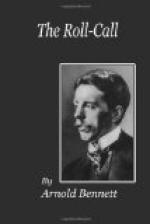The gesture was dramatic, and none knew it better than Mr. Enwright. The cupboard was the cupboard which contained the skeleton. It was full of designs rejected in public competitions. There they lay, piles and piles of them, the earliest dating from the late seventies. The cupboard was crammed with the futility of Enwright’s genius. It held monuments enough to make illustrious a score of cities. Lucas & Enwright was a successful firm. But, confining itself chiefly to large public works, it could not escape from the competition system; and it had lost in far more competitions than it had won. It was always, and always would be, at the mercy of an Assessor. The chances had always been, and always would be, against the acceptance of its designs, because they had the fatal quality of originality combined with modest adherence to the classical tradition. When they conquered, it was by sheer force. George glanced at the skeleton, and he was afraid. Something was very wrong with architecture. He agreed with Mr. Enwright’s tiresomely reiterated axiom that it was the Cinderella of professions and the chosen field of ghastly injustice. He had embraced architecture; he had determined to follow exactly in the footsteps of Mr. Enwright; he had sworn to succeed. But could he succeed? Suppose he failed! Yes, his faith faltered. He was intensely, miserably afraid. He was the most serious man in Russell Square. Astounding that only a few minutes ago he had hung triumphantly by his feet from the mantelpiece!
Mr. Enwright kicked-to the door of the cupboard.
“Look here,” he said to his partner, “I shan’t be back just yet. I have to go and see Bentley. I’d forgotten it.”
Nobody was surprised at this remark. Whenever Mr. Enwright was inconveniently set back he always went off to visit Bentley, the architect of the new Roman Catholic Cathedral at Westminster, on the plea of an urgent appointment.
“You had a look at the cathedral lately?” he demanded of George as he left.
“No, I haven’t,” said George, who, by reason of a series of unaccountable omissions, and of the fullness of his life as an architect and a man of the world, had never seen the celebrated cathedral at all.
“Well,” said Mr. Enwright sarcastically, “better take just a glance at it—some time—before they’ve spoilt the thing with decorations. There’s a whole lot of ’em only waiting till Bentley’s out of the way to begin and ruin it.”
II
Before the regular closing hour of the office the two articled pupils had left and were walking side by side through Bloomsbury. They skirted the oval garden of Bedford Square, which, lying off the main track to the northern termini, and with nothing baser in it than a consulate or so, took precedence in austerity and selectness over Russell Square, which had consented to receive a grand hotel or ‘modern




